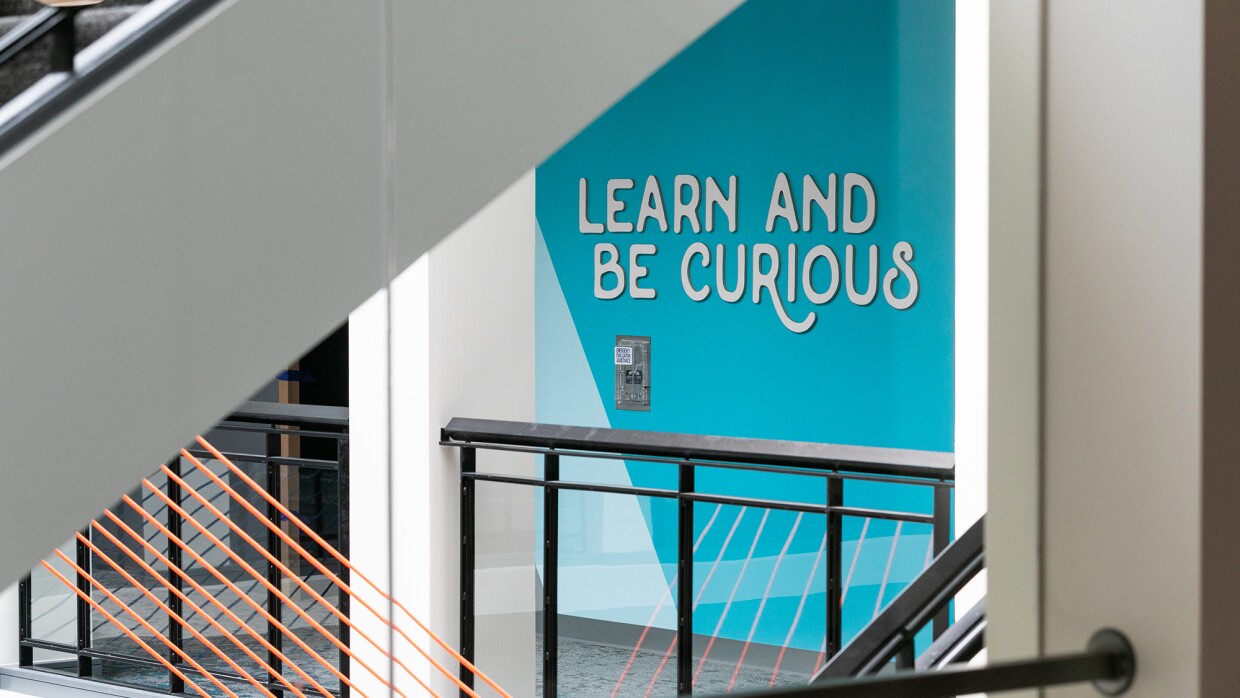Amazon’s Leadership Principles are a set of guidelines for how we think about behaviours within the business. There are 16 in total, and they are the framework of how we evaluate potential candidates for jobs here at Amazon.
As part of her role as an Amazon Bar Raiser, Liz Jones is a highly trained expert in the 16 Leadership Principles and is often involved in the interviewing process. The goal of the Bar Raiser programme is to bring objectivity to interviews and, in an effort to fuel innovation at Amazon, help make sure every new hire has growth potential and brings skills and abilities that are better than 50% of their would-be peers in similar roles.
We sat down with Liz to get a deeper understanding of the Leadership Principles, and what each of them mean in both theory and in practice.

What are the Leadership Principles and how are they used at Amazon?
They are a guiding set of tenets which Amazonians use every day to move forward in situations, solve problems, deal with conflict, and make decisions. Take ‘Ownership’ as an example. This Leadership Principle is the difference between saying ‘that’s someone else’s problem’ when you identify an issue, versus making sure it’s being addressed and the best solution is found.
They are the building blocks of culture at Amazon; they set the standard for how we should work with each other as a group of employees and they maintain standards and consistency across our many functions and geographies. The Leadership Principles allow us to interact with each other or approach problems with the same mindset and expectations. They have been integral for scaling growth successfully.
Can someone learn and develop the Leadership Principles or are they personality traits?
There is an element of some of the principles being innate. ‘Earns Trust’ requires good relationship building and soft skills which can be difficult to teach. But really, there is nothing that can’t be coached, especially with the right mentor. Most can be taught. Take ‘Dive Deep’ as an example. Analytical skills can be taught and there are problem solving methodologies which can help people build that skill too. Since I joined Amazon, I’ve improved my skills related to ‘Dive Deep’ and ‘Customer Obsession’.
Is there a risk of not hiring diversely when using the Leadership Principles?
Quite the opposite! Having a hiring process with mechanisms like Bar Raisers ensures that we look at all the evidence presented to us by candidates, and that we take a well-rounded view. Hire and Develop the Best leaves room for candidates to improve on certain behaviours, we don’t expect someone to score high on every single principle in an interview.
Diversity in our talent pool is something that the Leadership Principles encourage. There are certain Leadership Principles that are critical to work at Amazon, and others that are in varying levels across our employees. We sometimes talk about superpowers, which are skillsets or behaviours that have their own value outside of the leadership principles. It’s also likely that there is someone on their team who was hired to complement those ‘superpower’ strengths and their weaknesses.
Are some Leadership Principles more important than others?
All Leadership Principles are considered equal. However, depending on the role, a candidate may be asked about several principles specific to that job. You can generally tell from the job description.
In practice, interviewers expect to hear examples from candidates’ experience in their answers, and these should demonstrate different Leadership Principles. The interview process itself is an exercise in ‘Dive Deep’ for the panel, so a candidate must present their best evidence to succeed!
Is there tension and contradictions between any of the Leadership Principles?
I think the best example to explain this is ‘Dive Deep’ and ‘Think Big’ (or even ‘Bias for Action’): they are friendly foes. When looking deep into data to help you make a decision, you risk getting what I like to call ‘analysis paralysis’. You can dive so deep that you lose sight of the bigger picture, and this approach risks delaying your plan of action.
The tension between certain principles is completely intentional, though. it’s about giving us space for balance. We should be able to balance ‘Insist on the Highest Standards’ with our ‘Bias for Action’. The tension pushes us to make good decisions by exploring the boundaries of each principle.
Do the Leadership Principles apply to all job roles at Amazon?
Regardless of the job you do at Amazon, all Leadership Principles will be applicable. They are written so they apply to our culture as a whole. For instance, every single role at Amazon and everything we do starts with ‘Customer Obsession’. We always start with the customer and work backwards. A customer doesn’t always mean someone who shops on amazon.co.uk. For our sales employees, a customer can be a business that uses Amazon Web Services; for a software development engineer, a customer can be an internal team at Amazon.
How should a candidate get ready for an interview at Amazon?
Preparation is key! Candidates need to focus on the STAR method; Situation, Task, Action, Results. To level-up, they should add an ‘Improvement’ on the end to make it the STARI method.
This helps interviewers at Amazon really understand from a candidate what the context of a problem was, and the impact of their solution. They should focus on actions they personally took in the situation rather than their team. It’s important for the panel to understand the scope of their example in terms of reach, results, the data points that support it, and any details that add context.
Three key things to take away: use the STAR method; provide data where possible; and give the interviewers context.

Let’s talk about what each of the Leadership Principles mean, starting with Customer Obsession:
Above all else, we make decisions and take actions that make sure our customers are prioritised, we absolutely obsess over them. The job is never finished on customer obsession, we are always striving to be better.
A great example of this is Amazon Prime Delivery. When we first started delivering to customers, the delivery speed was five days. Customers didn’t ask for Prime but, because we obsess over our customers, we wanted to give them a faster delivery experience. Today, in certain circumstances, we have same day delivery available, and our teams will continue to work to make delivery more convenient and fast for our customers.
An interview panel will want to know how a candidate has demonstrated this principle by going above and beyond for their customers, and will need to hear evidence of how they did it.
Ownership:
Everybody at Amazon is expected to be an owner. We think long-term and don’t believe in putting plasters over problems. Ownership is about taking responsibility for any issues that you come across, thinking of solutions that consider the whole business and are long term.
Take, for instance, Weekly Business Reviews (WBR), a decision-making mechanism made famous by Amazon that promotes accountability among individual employees in their teams. These meetings take place from executive level down to smaller teams. During the short meeting, metrics and analysis are presented by the ‘metric owners’. Metric owners understand their numbers inside-out and explain any variations and reasons for KPIs being missed or exceeded.
Ownership goes beyond taking part in this mechanism, though. An employee at any level might notice that their WBR process for collecting business metrics is very manual, or that it isn’t working. Ownership means they would take responsibility for improving it. If they are a graduate, they could suggest some way to automate this for their team. If they are a senior manager, they should delegate the task of fixing it, but take ownership for scaling this fix across countries, and perhaps working with the right stakeholders to see if it could be scaled across other functions too.
What a candidate needs to do is demonstrate that they’ve uncovered or highlighted an issue themselves. They should show how they took steps to understand and resolve it, seeing it through to the end.
Invent and Simplify:
This means implementing smart and easy solutions. It’s about looking at processes, identifying if there’s a defect, and then figuring out how to simplify and improve.
Amazon teams demonstrated Invent and Simplify in how they improved the process of uploading products to our online stores, making it more efficient. Ten years ago, we were uploading spreadsheets manually, now our independent selling partners and vendor partners can add products to the store themselves quickly and easily.
A candidate might be asked to talk about how they put a simple solution in place for a complex problem, and it’s important they demonstrate just how complicated the situation was to begin with.
Are Right, A Lot:
This principle is about being wrong a lot, too! It’s about having the confidence and good judgement to know when you’re right and when you’re wrong. It’s also about taking feedback from others, no matter how convinced you are of a path forward, and challenging your biases. People who really live this principle sit down with those who challenge them and try to understand why they think what they think. They then ingest this information and use it to form or disprove their own beliefs.
It’s super important when we make hiring decisions, and when we make ‘one-way door’ decisions for the business – this is what we call a decision that we couldn’t easily undo.
We use Are Right, A Lot for ourselves when we make hiring decisions. As a team, we’ll have a roundtable discussion after each interview round, where we’ll look to find examples and challenge any concerns that each of us might have. It’s also a Leadership Principle that you can keep developing, especially in leadership positions: we have a lot of training relevant to this at Amazon, such as challenging unconscious bias.
Learn and Be Curious:
Learn and Be Curious is about kicking the tyres, poking around, and trying to understand things. It’s about always learning more and having a thirst for knowledge with the intention of solving a problem or improving something.
This principle can be applied to any area, as long as the purpose of your research is always to improve something and it explores a potential business opportunity in that area. If we don’t have a natural curiosity to understand customers’ needs and to understand how these are developing, even in industries that seem outside of our current offering, we won’t be able to realise the opportunity to offer new products and services to our customers.
This principle is important in maintaining our growth and preserving our customer focus.
Hire and Develop the Best:
This Leadership Principle is about identifying talent and helping our people grow. It’s not only applicable to people managers: you can also coach, support or help your peers or other teams in a mentoring capacity, and that is still Hire and Develop the Best.
For potential managers, I want to hear about how that candidate thinks about their people, how they put a team together, then how they coach, develop, mentor and review that team. If there are performance issues, we want to hear about how that’s dealt with early and what mechanisms they put in place to support individuals to realise their full potential. Giving time to assess and nurture performance is so important, and we want to hear evidence of how they do that.
For someone who won’t be managing people, it’s slightly different. It’s about how you coach, mentor and develop your peers. It’s about stepping in to help and making sure that you are sharing knowledge. This might mean sharing your knowledge on a different function, offering training, or supporting a hiring day for different minority groups.
Insist on the Highest Standards:
This principle is strongly linked to Customer Obsession. Companies often talk about launching a minimal viable product, but here at Amazon we talk about a minimal loveable product. We want our customers to have a great first experience when they engage with our products. It’s the difference between launching a beta product with some bugs and launching a beta product that is 99% there.
Insist on the Highest Standards ensures the standards we hold are high, and we continue to keep them high. This can apply to anything, from building a new website function to writing an internal document. We are always challenging ourselves and each other to be better.
Fulfilment by Amazon is a great example of this principle in action. This programme allows independent selling partners – many of whom are small and medium sized businesses – to access the Amazon Fulfilment Network to get their products delivered to customers quickly. From the seller’s perspective, it means they can have the Prime Delivery badge on their products, and for our customers it means they get that seamless customer experience when they order a product on Amazon. We created Fulfilment by Amazon because we insisted on the highest standard for both our customers and our selling partners.
A candidate needs to show that they can challenge the status quo, giving examples that demonstrate how they strive to make things better instead of becoming complacent.
Think Big:
Think Big is an analogy for thinking outside of the box, taking off the blinkers and looking at the world around us. It means trying to solve problems that aren’t necessarily within our wheelhouse right now.
An example of Think Big is Amazon Studios. Our involvement in the film industry started as selling DVDs on the website, then it evolved into having a streaming service. Amazon Studios was a solution to creating content that could fuel those first two offerings.
Amazon Web Services (AWS) is another Think Big idea. The biggest needle movers are things that customers don’t know how to ask for, and come from tapping into our own inner imagination about what’s possible. No one asked for AWS, ever. However, it turned out that the world was ready for a cloud computing service like AWS. We followed our curiosity, took necessary financial risks and began building (and iterating countless times) until we had a service that was ready for customers.

Bias For Action:
Bias For Action means ‘just do it’. It’s about looking at a problem, weighing up the risks and benefits, figuring out a solution fast and then just doing it. For a company, sometimes being slow can imply much higher costs than taking quick action. This is one more reason for us to support a Bias for Action approach.
Most solutions will be ‘two-way doors’, which means they can be changed and aren’t set in stone. As a result, you don’t always need to spend lots of time on due diligence and analysis. It’s much better to do it, find out the impact, get the data and then iterate your process.
An example is A/B testing different functions for user experience on the website. This can be easily switched on and off, and it’s possible to gather the data on how certain functions worked. Then we optimise the successful ones.
Frugality:
Frugality is about value. It’s doing the most you can with what you’ve got and challenging yourself to do more with less. Frugality aligns directly with Invent and Simplify because having constrained resources helps us drive invention, we innovate to overcome any resource limits.
In practical terms, we have a finite amount of resources to work with, and we always want to maximise how far those resources can go. We prioritise resource based on customer benefit and on the long-term value that could be created.
Jeff Bezos once said that every internal team should be small enough that it can be fed with two pizzas. This isn’t about cutting costs, it’s about focusing on scalability and efficiency. Smaller teams can communicate better, manage resources more effectively and be more dynamic in general.
Earn Trust:
This principle is all about over communication and honesty, while still being very frank and quick. Amazon is a highly matrixed organisation where managing stakeholders is a vital skill. Earning trust is pivotal to this. This principle means making sure people know exactly where they are with things, and admitting when something is going wrong so it’s possible to put steps in place to make sure it doesn’t happen again. It’s essentially about being honourable.
In reality, Earn Trust is demonstrated the most when things go wrong! At Amazon, if something goes wrong, we try to admit this, then very quickly put steps in place and align people to make sure it gets back on track.
Dive Deep:
There are two parts to Dive Deep – quantitative and qualitative. It’s about picking through the layers to get to the root cause of a problem, staying connected to the data and then forming an opinion. Amazon has a data-driven approach that touches all aspects of our culture, from our processes to our conversations with colleagues. A mechanism we use here is the ‘five whys’, this is where we work through a problem by asking ‘why’ until we arrive at the true root cause of something.
For example, if your customer feedback doesn’t match your numbers, then you would probably go with your customer feedback over the statistics, because you know they are real life anecdotes. This means that there might be an issue with your analysis. It’s about really interrogating what you’re being told and getting to the bottom of something.
Have Backbone; Disagree and Commit:
This Leadership Principle means standing up for an idea using data rather than your opinion. If your challenge is not successful, it’s also about committing to that decision and getting on with things.
We challenge respectfully and responsibly when we believe something isn’t right. It doesn’t matter who it is, we push back if we disagree. If two people can’t agree, we escalate it. Once a decision has been made, we all commit to it and move forward.
This principle works well alongside Are Right, A Lot: used together, they make sure we consider diverse perspectives and agree on the best way forward.
Deliver Results:
This isn’t just about delivering results; it’s about overcoming obstacles, and the work you do to overcome them and deliver. It’s about rising to the occasion and never settling, even with perceived blockers in your way.
When individuals or teams at Amazon miss their target, they work to understand why it happened. When people at Amazon succeed, they make sure to understand why they succeeded. We always ask ourselves what we would do differently, and what did we learn.
In 2021, Amazon added two new leadership principles to the original 14:
Strive to be Earth’s Best Employer:
At Amazon, we raise the bar every day, in all aspects of our professional life. Our working culture is no exception: we expect leaders at Amazon to strive every day to build a safer, more productive, more diverse and just working environment. We want our employees to lead with empathy, listen to their colleagues and have fun at work. Leaders should champion other employees’ personal successes and ensure they are empowered to grow and embrace the next challenge.
This principle can be demonstrated through a variety of actions, big and small. For instance, one member of my team demonstrated this well by creating educational sessions to help the whole team understand Diversity, Equity and Inclusion topics in more depth and encourage discussion.
Success and Scale Bring Broad Responsibility:
Many people know the story about how Amazon was started in a garage, but we’re not there anymore. We have grown, and we are aware of our size and our impact. This is why we expect our leaders to be humble and always take into consideration the effects of Amazon’s actions, even indirect ones.
At Amazon, we consider our impact on local communities, our planet and future generations. Leaders should create more than they consume, and always work to leave things better than how they found them.
This principle is important because it’s our mission to make a difference in the world by empowering and supporting our teams to actively build long-lasting solutions to some of society’s biggest challenges. Examples shared for this principle should demonstrate a candidate’s ability to take into careful consideration the consequences that a decision, no matter how small, may have, and to embed that into their decision-making process. We want to hear a candidate show their understanding of the broader impact of their work, beyond their day-to-day activities, and we want to know that they will seek to have a positive impact while working at Amazon.

Learn more tips for interviewing at Amazon.











